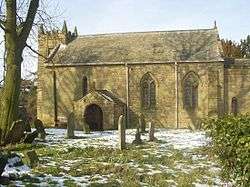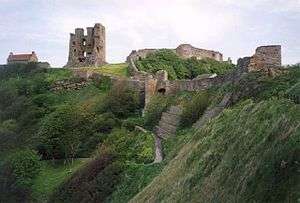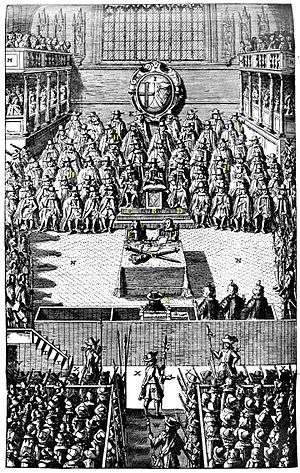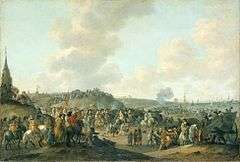Francis Lascelles
Francis Lascelles (1612-1667), also spelt Lassels, was an English politician, soldier and businessman who fought for Parliament in the 1639-1652 Wars of the Three Kingdoms and was a Member of Parliament between 1645 and 1660.
Francis Lascelles | |
|---|---|
 St Lawrence, Kirby Sigston, where Francis was buried | |
| MP for Northallerton | |
| In office April 1660 – June 1660 resigned | |
| Monarch | Charles II |
| Preceded by | Sir David Foulis |
| Succeeded by | Ralph Milbancke |
| MP for Yorkshire & North Riding | |
| In office September 1654 – February 1658 | |
| Monarch | The Protectorate |
| Succeeded by | John Dawnay |
| Nominee for Yorkshire | |
| In office July 1653 – December 1653 | |
| Monarch | Commonwealth of England |
| Preceded by | None |
| Succeeded by | None |
| MP for Thirsk | |
| In office 1645 – April 1653 | |
| Monarch | Charles I (1645-1649) Commonwealth of England |
| Preceded by | John Belasyse excluded 1642 |
| Personal details | |
| Born | 23 August 1612 (baptised) Stank Hall, nr Kirby Sigston Yorkshire |
| Died | 25 November 1667 (aged 55) Kirby Sigston |
| Resting place | St Lawrence, Kirby Sigston |
| Nationality | English |
| Spouse(s) | Frances, 1626-1658 † |
| Children | Elizabeth (1640-1694), Daniel (1655-1734) |
| Parents | William Lascelles (died 1624) Elizabeth Wadeson (died 1647) |
| Residence | Stank Hall |
| Alma mater | Gray's Inn 1629 |
| Occupation | Politician, businessman and soldier |
Although nominated to the Commission that tried Charles I in 1649, he did not sign the death warrant and largely escaped punishment after the 1660 Restoration, although he was fined and barred from holding public office.
Life
The Lascelles were part of a network of mercantile interests in London, Yorkshire, Ireland, New England and Barbados. While unconnected to the aristocratic family of the same name, various branches were spread across Yorkshire, including Northallerton, Durham, Whitby, York, Harewood House and Terrington. The family tended to use the same names (Thomas, Francis, Robert, Henry etc.), which often causes confusion.
Francis Lascelles was born in August 1612 at Stank Hall, near Northallerton, eldest son of William Lascelles (died before 1624) and Elizabeth Wadeson (died 1647). He had three brothers, Robert (1617, died before 1640), Peregrine (1619-1658) and Thomas (1624-1697).
In 1626, he married Frances St Quentin (1613-1658) and they had 16 children, only two of whom outlived their parents; Elizabeth (1640-1694) and his youngest son, Daniel (1655-1734). He died at home in November 1667 and was buried in the local church of St Lawrence.
Career

Like many of his friends and relations, Francis supported Parliament during the 1639-1652 Wars of the Three Kingdoms; with his brothers Thomas and Peregrine, he is named in the Ordinances of Parliament as one of those responsible for raising money and men in Yorkshire and a signatory of the 1643 Solemn League and Covenant.[1]
At the beginning of the First English Civil War in 1642, many on both sides were related to their opponents and thus reluctant to initiate hostilities. In October, Thomas Fairfax, later commander of Parliamentary forces in the North, signed a pact of neutrality with a Royalist delegation led by his cousin Sir John Belasyse. This was denounced in writing by other supporters of Parliament, including Francis, who replaced Belasyse as Member of Parliament for Thirsk in 1645.[2]
By the time the Second English Civil War broke out in 1648, Francis was a colonel and played a significant role in the campaign that ended with the defeat of the Royalist army at Preston in August. He then joined the force besieging Scarborough Castle, a key supply port in the north of England that changed hands seven times between 1642 and 1648. The Parliamentary garrison defected after not being paid and it received substantial Royalist reinforcements, including 300 Walloon mercenaries. The castle surrendered in late December; the increasing bitterness of the conflict was demonstrated by the killing of a number of Walloon prisoners, who were 'mistaken for Irish.'[3]

The increasing bitterness of the conflict was demonstrated by the killing of a number Between 1642 and 1648, England suffered an estimated 185,000 deaths from combat or disease, over 3.0% of the population; this compares with 2.6% in 1914-1918, while death rates in Scotland and Ireland were considerably higher.[4] After 1648, Parliamentary leaders like Cromwell and many members of the New Model Army believed Charles could not be trusted and only his death would end the conflict. Lascelles was nominated to the High Court of Justice set up for the trial, as one of the relatively conservative group of property-owning senior military officers known as 'Grandees'.[5]
Of the 135 members nominated, only 68 attended, including Lascelles; he was absent when sentence was passed and did not sign Charles' death warrant, acts that later proved extremely important. Charles was executed on 30 January 1649 and Francis then participated in the Cromwellian conquest of Ireland.

The 1641 Irish Rebellion led to intervention by the Scottish Covenanter government and the English Parliament, although the two parties had different objectives. English participation was financed by the Adventurers Act of March 1642, approved by Charles and Parliament shortly before the civil war began in August. It raised loans that would be repaid by confiscating and reselling lands held by the Irish rebels and enforcing it was one of the primary objectives of Cromwell's invasion.[6]
There were a number of different tranches between 1642 and 1647 and although Lascelles is not listed as a subscriber, many of the individuals represented syndicates of investors, while there was an active resale market. Lands were only allocated in 1652 with the Act of Settlement but many subscribers sold their interests prior to that. It seems likely Francis was involved, since he and his brother Thomas had business interests in Ulster and a branch of the family was established in Killough, County Down.[7]
Lascelles kept his seat as MP for Thirsk in the 1648 to 1653 Rump Parliament, so-called because the Army purged those members it considered hostile. He retained it until Parliament was dissolved in April 1653 and was one of the 140 members nominated by the Army Council to the Barebones Parliament, which was in place from July to December 1653. After elections were restored in 1654, he was returned as MP for Yorkshire & North Riding in the First and Second Protectorate Parliaments.[8]
When Cromwell died in 1659, it soon became clear his son and successor Richard could not govern and Lascelles was one of those who negotiated with General George Monck to restore the monarchy. The Commonwealth ended in 1660 with the return of Charles II to the throne and in April, Francis and his brother Thomas were elected to the Convention Parliament as Members of Parliament for Northallerton. However, in July he and Thomas deemed it prudent to resign their seats and go into exile in the Dutch Republic.

Despite his role in the Restoration, as a member of the High Court that tried Charles I, he was technically one of the Regicides who were excluded from the Indemnity and Oblivion Act. Many were condemned to be hung, drawn and quartered, while the corpses of Cromwell, Bradshaw and Ireton were dug up and dragged to Tyburn gallows.[9] Francis was saved partly because he was absent during sentencing but also because ministers grew concerned by public reaction to the deaths. Even Pepys, who was closely connected to the new regime, recorded his admiration for the conduct of Thomas Harrison at his execution in October 1660.[10]
The Lascelles were indemnified and allowed to return home, although Francis was fined and perpetually barred from holding public office.[11] In December 1662, Francis was accused of being involved in the so-called 'Lascelles Plot,' a conspiracy of former New Model Army soldiers and radicals centred on Northallerton; this proved to be a fabrication by government informers, while the actual Rising in October 1663 quickly collapsed.[12]
Francis died at Stank Hall in November 1667.
References
- Jones, John (1859). History and Antiquities of Harewood, in the County of York, with topographical notices of its parishes and neighbourhoods. Simpkin, Marshall & Co. p. 291.
- Hopper, Andrew (2007). Black Tom: Sir Thomas Fairfax and the English Revolution. Manchester University Press. pp. 27–28. ISBN 978-0719071089.
- Hinderwell, Thomas (1832). The history and antiquities of Scarborough (Third ed.). J Bye and Whittaker & Co. pp. 81–84.
- Fowler, David. "English Civil War Casualties". Oliver Cromwell. Retrieved 25 February 2019.
- Plant, David. "Agitators". BCW Project. Retrieved 25 February 2019.
- Manganiello, Stephen (2004). The Concise Encyclopedia of the Revolutions and Wars of England, Scotland, and Ireland, 1639-1660. Scarecrow Press. p. 160. ISBN 978-0810851009.
- Smith, SD (2010). Slavery, Family, and Gentry Capitalism in the British Atlantic: The World of the Lascelles, 1648-1834. Cambridge University Press. p. 55. ISBN 978-0521143004.
- Henning, BD. "LASCELLES, Francis (1612-67), of Stank Hall, Kirby Sigston, Yorks". History of Parliament Online. Retrieved 26 February 2019.
- "House of Commons Journal Volume 8: 15 May 1660". British History Online. Retrieved 19 February 2019.
- "Saturday 13 October 1660". Pepys Diary. Retrieved 20 February 2019.
- HMSO (1819). Statutes of the Realm, Volume 5: 1628-80. pp. 226–224.
- Hopper, Andrew (2002). "The Farnley Wood Plot and the Memory of the Civil Wars in Yorkshire". The Historical Journal. 45 (2): 288–289. JSTOR 3133646.
Sources
- Fowler, David. "English Civil War Casualties". Oliver Cromwell.
- Hopper, Andrew (2002). "The Farnley Wood Plot and the Memory of the Civil Wars in Yorkshire". The Historical Journal. 45 (2).
- Hopper, Andrew (2007). Black Tom: Sir Thomas Fairfax and the English Revolution. Manchester University Press. ISBN 978-0719071089.
- Jones, John (1859). History and Antiquities of Harewood, in the County of York, with topographical notices of its parishes and neighbourhoods. Simpkin, Marshall & Co.
- Hinderwell, Thomas (1832). The history and antiquities of Scarborough. J Bye and Whittaker & Co. pp. 81–84.
- Manganiello, Stephen (2004). The Concise Encyclopedia of the Revolutions and Wars of England, Scotland, and Ireland, 1639-1660. Scarecrow Press. ISBN 978-0810851009.
- Plant, David. "Agitators". BCW Project.
- Smith, SD (2010). Slavery, Family, and Gentry Capitalism in the British Atlantic: The World of the Lascelles, 1648-1834. Cambridge University Press. ISBN 978-0521143004.
| Parliament of Great Britain | ||
|---|---|---|
| Preceded by Thomas Kennedy |
MP for Northallerton April 1660 - July 1660 |
Succeeded by William Steuart |
| Preceded by Vacant |
MP for Yorkshire, North Riding 1653 – 1659 |
Succeeded by John Dawnay |
| Preceded by John Belasyse |
MP for Thirsk 1645 – 1653 |
Succeeded by John Dawnay |